|
The
Klondyke Horse Sanctuary
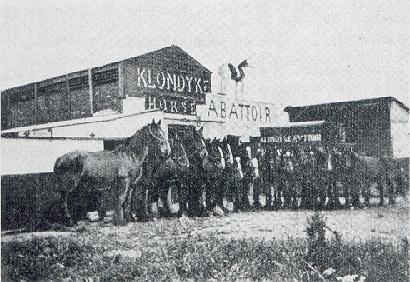
One of the more unusual establishments in Bourne during the early 20th century was a sanctuary for horses which were past their working lives and about to be put down. Today, these animals are invariably put out to grass but in those days there was a brisk trade in buying them for killing, usually in callous and painful circumstances, or sending them to the Continent for a similar fate, and after a distressing sea voyage, often in cruel and unhygienic conditions, they were killed for food. The trade in horses and the questionable circumstances in which they were bought and sold, became a cause célèbre for those who were dedicated to the welfare of animals and there was soon a
clamour for changes in the law that would give some dignity to horses in old age.
Miss Ada Cole
(1860-1930) became distressed by the treatment of old and worn out work horses in this fashion and in 1927, she founded a charity known as the International League for the Protection of Horses in an attempt to bring about reforms. She also wanted to show the rest of the world that horses need not suffer in this way and so the following year, in 1928, she set up the Klondyke Horse Sanctuary on rented land situated just off West Road, Bourne, near to the brick pits on the outskirts of the town, which was designed to demonstrate that horses could be slaughtered humanely and to act as a model for other abattoirs.
The establishment of the abattoir was recorded in the minutes of the
league the following year:
Substantial help from an anonymous benefactor
connected with our league has made it possible to start a little model
horse abattoir. A very suitable man was given all that is necessary to
start the work, on the one condition that it should be first of all
humane. He is running it as his own, which in fact it is, but our league
has sent him a considerable amount of money, which it will never recall so
long as conditions are as they should be. An agreement has been signed
between him and the League, and we have every hope of success.
An ambulance conveys horses that are stiff, or old or rheumatic. They are taken to a stable at some distance from the place of slaughter, where food and water must always be within their reach; where they have bedding; and are so tethered that they can lie down. They are then taken one by one to a slaughter shed, and immediately killed with the killer. The carcase is taken away after the killing of each horse and the place thoroughly washed down. The man who fetches the horses takes a killer with him so that if necessary a horse may be killed without being moved. Visitors are invited to inspect the stable and slaughterhouse without warning at any time.
It is a little place, a tiny beginning, but we hope that farmers and other
people will prefer to send their horses to such conditions, and if we can
once prove that 'humanity first' and commercial success can go together in
this work, we hope that other horse abattoirs will be worked on the same
lines. But, in the beginning, conveyance, food, and other humane
necessities cause considerable additional expenses. We shall be glad to
give all information about this abattoir to anyone interested in it. And
we hope some of our subscribers will visit it.
The sanctuary had a good reputation during its years of operation under the motto "A little model horse abattoir" and the horse ambulance mentioned by the league, and which was used to pick up sick animals, soon became a familiar sight in the Bourne district.
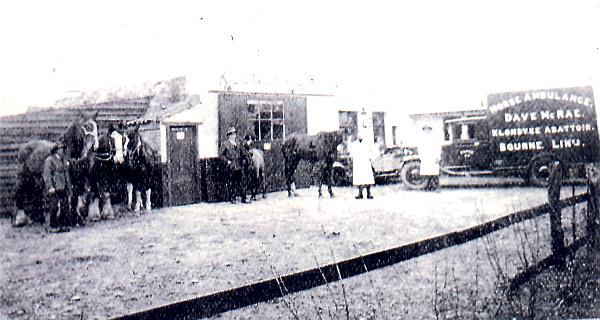
There was also a large paddock with good grazing, a pond fed by an underground spring, a crew yard and comfortable stables. New buildings were erected and proper drainage installed and as this increased the value of the property, the league bought the freehold and
started making plans to use the nearby railway sidings to bring in further business.
After 18 months of trial and experiment, the abattoir was dealing with nine horses a week and had been established as a paying business although it could not meet additional expenses for the humane treatment of horses and could not therefore compete with the ordinary dealers because there was great competition in the trade and therefore many dubious practices existed. The league solved this financial problem by separating the stables from the abattoir into two separate businesses and contributing to those facilities needed to maintain the humane aspects of the operation and in March 1931, they took over the entire management of the operation themselves.
In 1932, an agreement was reached with Messrs T W Mays and Sons Ltd, the local fellmongers, to run the abattoir with a representative from the league, Mr Ronald Burchnell, permanently in attendance and this new arrangement worked satisfactorily. By 30th June 1933, the number of horses handled annually had reached 731 and the statistics reveal the varied nature of the work: heavy draught horses 619; vanners 31; hunters 5; hackneys 28; ponies 48. In the same year, the electricity installation and water pumping plant were overhauled and a new horse ambulance purchased fitted with additional side doors to facilitate the loading and unloading of debilitated animals.
|
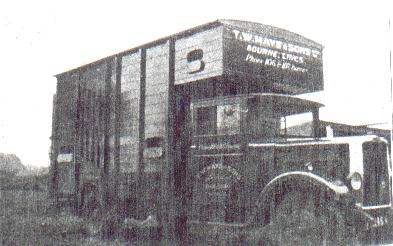 |
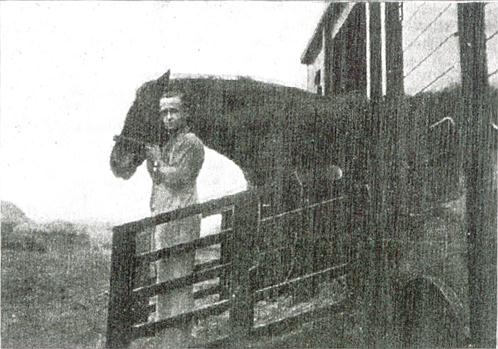 |
|
The new and larger
horse ambulance introduced in 1933 was specially designed to take
sick animals that had difficulty in walking. |
This enabled the league cover a
wider area and in 1937, a depot was established at Melton Mowbray in Leicestershire, and progress continued to improve and extend the abattoir and its surrounds and in 1939, an artesian well was sunk on the property to provide its own water and a tank with a 2,000 gallon capacity installed to maintain supplies during all weathers. In that year, the number of horses slaughtered at the abattoir reached 818, among them a large number of pit ponies that had been brought in from the coalfields by rail. The league proudly reported: "When the alterations are complete, Klondyke will probably
be the most up-to-date horse abattoir in the country."
The number of horses being brought in declined dramatically during the Second World War of 1939-45, mainly due to the emergency conditions prevailing in the country and the rationing of petrol that restricted travelling although there was a heavy demand for horse flesh throughout Britain to supplement rationed meat and supplies from the Klondyke were readily sold. Mr Burchnell, now known as the league's superintendent, was called up for service with the Royal Air Force in 1942 and his work was carried out by an assistant who was also an experienced slaughterer although the league sent officials to make periodic visits to ensure that the abattoir continued to be run on the humane lines they had dictated and there were also spot checks by the Ministry of Food.
Mr Burchnell was demobilised from the RAF in April 1946 and resumed his work at the abattoir and as wartime restrictions were lifted, the search for horses went further afield. A number of army horses reached Klondyke that year, arriving in this country by sea and completing the journey by train and ambulance. Business was once again picking up and by the end of 1946, the abattoir was handling almost 1,000 horses a year. The population of horses in the country however, had fallen considerably and the scarcity was causing a black market in horseflesh. As a result, the prices being paid were greatly in excess of
those quoted in the government controls and even work worn horses were selling from 35 to 45 guineas each. The black market in horseflesh continued until 1948 when the activity lessened as food restrictions began to relax.
On 30th June 1950, the league reported: "Conditions are slowly returning to normal. For the first time since the end of the war, the large horse dealers stopped giving the very high prices at farm sales and auctions that they had been paying. The removal of price controls appeared to make little difference to the amounts paid for horses for slaughter but it gave the legitimate horse dealers and slaughterers an equal chance of competing in the open market against the black market operators, and that was a big step towards restoring more normal conditions."
But the general trade in horses was beginning to change as mechanisation reduced their numbers on the farms. The league reported: "The horse population in Lincolnshire and the adjoining counties continues to fall rapidly and on a great majority of the farms where previously large numbers of horses were working, only one or two are now kept and they have little work to do. There was a heavy demand for horse flesh during the greater part of the year, but occasionally the demand fell for short periods."
The work of the abattoir continued to receive high praise in official circles and during 1955, inspectors from the Ministry of Food and from the local authorities expressed their complete satisfaction with the work being done
there and later that year, the
licence, which had previously permitted only the slaughter of horses at Klondyke, was extended to the slaughter of other animals. During this period, the ownership of the abattoir passed to Messrs T W Mays and Sons Ltd who were therefore extending their business and had also taken over an additional acreage of grassland nearby to provide grazing facilities and hay for animals awaiting slaughter. At the same time, Raymond
Burchnell, the league's superintendent who had been their representative at Klondyke for the past 25 years, was appointed a full- time investigator for the league and his work was left to occasional visits from league officials.
Nevertheless, Mays continued to observe the code of conduct laid down by the league who reported: "Close contact is kept with Messrs T W Mays and Sons Ltd who own the abattoir and run it in an exemplary fashion and continue to combine commerce with humanity."
In 1958, the league reported: "The frequent visits made to the abattoir and the long association of the league and Messrs Mays have proved beyond doubt that humane and commercial interests can work together successfully to obviate cruelty in slaughterhouses." The number of horses passing through was declining rapidly and by the following year, the number had dropped to 205 which was 60% less than two years earlier. Furthermore, there had been a considerable improvement in the condition of old and worn
out horses being brought in. The figure dropped even further to 121 in 1960 and in the following years, most of the business handled was other animals.
The abattoir continued to operate until 1973 when Messrs T W Mays and Sons Ltd
decided not to renew their licence, mainly as a result of the higher
standards then being demanded by the local authorities that would have
necessitated costly structural alterations to the premises. They were
eventually closed down and all of the buildings used by the venture have since been demolished and
much of the site redeveloped for housing. Few people in Bourne
today know of the name Klondyke or the venture associated with it yet under its auspices, more than 20,000 horses were slaughtered
there in less than fifty years.
|
The International
League for the Protection of Horses was founded in 1927 by Miss
Ada Cole (pictured right), its main aim being to prevent the
ill-treatment of horses exported to Europe for slaughter. Her work
was prompted by the sickening sight of old and exhausted
workhorses being whipped along a four-mile stretch of road to
their slaughter near Antwerp after being brought into Belgium by
boat. Legislation was subsequently introduced in both Britain and
Ireland to prevent this trade and the league continues its work
today to ban such activities in other countries, notably in Russia
and Eastern Europe. |
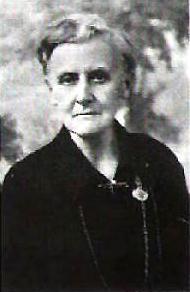 |
|

Antwerp customs officer: "Have you anything
to declare?"
British horse: "Only this - that I'm ashamed of my
country."
|
Among the more
vociferous campaigners against the live export of horses was the
Daily Mirror newspaper in London. Even after the trade from
Britain had been curbed, they discovered that horses were being
shipped out from Ireland. In 1961, reporters watched the
ships from Cork to Dieppe and then on the train journey to
abattoirs in Paris and the newspaper subsequently carried shock
reports exposing the trade. They also reproduced this Punch cartoon by
Bernard Partridge of 50 years earlier, highlighting the savage
cruelty the horses were forced to undergo. The law was eventually
changed by the Eire Parliament. |
See also Mays and Sons

Go to:
Main Index Villages
Index
|





